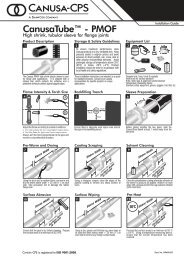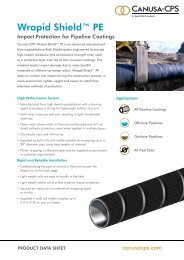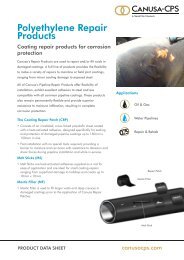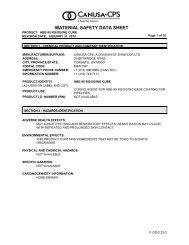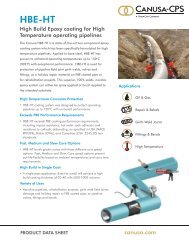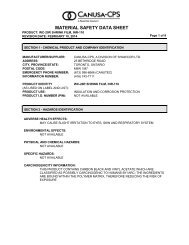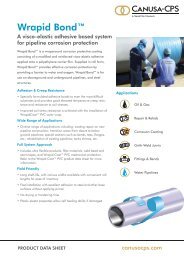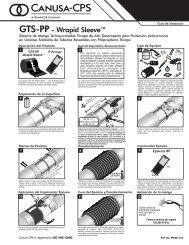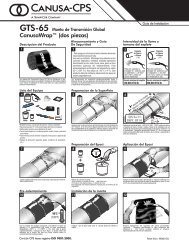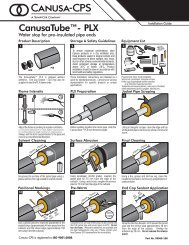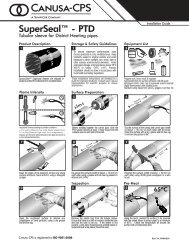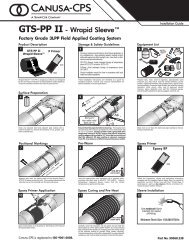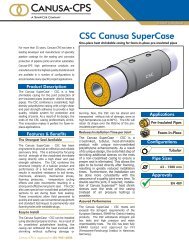Feeling the heat - Canusa-CPS
Feeling the heat - Canusa-CPS
Feeling the heat - Canusa-CPS
Create successful ePaper yourself
Turn your PDF publications into a flip-book with our unique Google optimized e-Paper software.
coatings<br />
<strong>Feeling</strong> <strong>the</strong><br />
<strong>heat</strong><br />
Robert Buchanan, <strong>Canusa</strong>-<strong>CPS</strong>, Canada, presents a detailed analysis of<br />
coatings designed for high operating temperature pipelines and <strong>the</strong><br />
test methods used to evaluate <strong>the</strong>m.<br />
High performance corrosion protection coatings for<br />
pipelines are constantly being required to perform<br />
on increasingly high operating temperature pipelines.<br />
In addition to high operating temperatures, <strong>the</strong>se<br />
pipeline coatings must withstand tough construction conditions,<br />
since many of <strong>the</strong> major oil and gas discoveries are<br />
in remote fields located in developing countries.<br />
Recent advancements in epoxy and multi-layer polyolefin<br />
coating materials have created coating systems that<br />
are pushing traditional temperature ceilings and are tough<br />
enough to survive <strong>the</strong> construction phase.<br />
However, in <strong>the</strong> absence of industry wide consensus<br />
standards and because <strong>the</strong>re are only a few owner specifications<br />
for high operating temperature pipeline coatings,<br />
each manufacturer or supplier of coating products for high<br />
temperature pipelines will make claims based on a variety<br />
of test parameters. Additionally, <strong>the</strong> requirement for high<br />
temperature pipeline coatings is relatively new and little<br />
history of performance data is available.<br />
Because of this, a NACE task group was formed to<br />
investigate <strong>the</strong> requirements for high operating temperature<br />
pipeline coatings and it has a huge challenge ahead<br />
of it. At <strong>the</strong> recent BHR conference on pipeline coatings 1 ,<br />
several papers were presented but none could definitively<br />
state what was important to long term performance.<br />
Pipeline coatings<br />
The development of pipeline coatings over <strong>the</strong> past 65<br />
years followed <strong>the</strong> natural progression of technology development<br />
required as a result of environmental, economic or<br />
performance pressures. The technologies in <strong>the</strong> mid 1900s<br />
were generally well suited for pipelines operating up to<br />
50 ˚C (122 ˚F). Until recently, maximum operating temperatures<br />
were in <strong>the</strong> 80 ˚C (176 ˚F) range and <strong>the</strong> coatings,<br />
again, met that need well. Pipelines today are required to<br />
operate at temperatures greater than 100 ˚C (212 ˚F) and<br />
fast approaching 150 ˚C (302 ˚F). At <strong>the</strong>se temperatures,<br />
<strong>the</strong> traditional methods of determining fitness for purpose<br />
are quite different than previously used.<br />
Figure 1. High temperature pipeline construction.<br />
REPRINTED FROM WORLD PIPELINES MARCH 2006
coatings<br />
coatings<br />
Table 1. Coating technologies and operating temperatures<br />
Technology/product Max operating temp. Prime properties<br />
FBE (standard) 65 ˚C T g<br />
(DSC)<br />
Water absorption<br />
FBE (high temp) 120 – 140 ˚C T g<br />
(DSC)<br />
Water absorption<br />
Dual layer FBE 130 ˚C T g<br />
(DSC)<br />
Water absorption<br />
Liquid epoxy (100% Solids) 150 ˚C Cathodic Disbondment<br />
(CD)<br />
3 layer polyethylene 90 ˚C 3 Shear<br />
indentation, CD<br />
3 layer polypropylene 130 ˚C Adhesion, indentation, CD<br />
Figure 2. High temperature pipeline construction in a remote<br />
environment.<br />
Performance parameters<br />
Typical industry wide performance standards and<br />
pipeline owner specifications include a number of<br />
performance measures with test methods specified.<br />
Many of <strong>the</strong> test methods are run at ambient temperature,<br />
at a specified maximum temperature or at<br />
“pipeline operating” temperature, i.e. T max<br />
. However,<br />
limitations in equipment capacity or limitations in <strong>the</strong><br />
test parameters may result in <strong>the</strong> testing being carried<br />
out at <strong>the</strong> maximum capability of <strong>the</strong> equipment<br />
or in a “modified” regime that may not represent inservice<br />
conditions.<br />
Additionally, manufacturers of coatings and/or raw<br />
materials for coatings will make claims of performance<br />
based on material properties, ambient test methods<br />
and one or two modified test methods. The question<br />
remains, what testing is required to determine <strong>the</strong> in-service<br />
high temperature performance of a coating?<br />
Table 1 is a summary of coating technologies with<br />
respective typical maximum pipeline operating temperatures<br />
listed and <strong>the</strong> traditional prime driver for <strong>the</strong> rated<br />
operating temperature identified.<br />
Table 2 is a summary of a number of material properties<br />
and potential test methods with parameters and<br />
relevance noted based on a review of <strong>the</strong> draft ISO 4 standard<br />
and existing ASTM 5 , French 6 , Canadian 7 and European 8,<br />
9<br />
coatings standards and test methods plus various pipeline<br />
owner specifications 10, 11 .<br />
This article describes a number of coating technologies<br />
and this inevitably invites classic “apples & oranges” comparisons.<br />
The coating technology must be considered with<br />
respect to what is important for a specific pipeline project.<br />
As an example, epoxy materials may be more suitable<br />
for dry non-aggressive soil conditions, whereas for wet or<br />
particularly aggressive soils, multi-layer coatings should be<br />
considered. Onshore versus offshore; <strong>the</strong> location of <strong>the</strong><br />
pipeline; and construction conditions; would also have an<br />
impact on <strong>the</strong> choice of coating system.<br />
The decision needs to be made by informed specifiers<br />
and may require consultation with specialists or with <strong>the</strong><br />
manufacturers of <strong>the</strong> coating products. 12<br />
Figure 3. High temperature CD apparatus. Photo courtesy of<br />
ShawCor Ltd.<br />
Additionally, as with mainline coatings, <strong>the</strong> field joint<br />
coating must perform in-service at a level that meets <strong>the</strong><br />
requirement of <strong>the</strong> line. Although <strong>the</strong> joint coating does not<br />
need to withstand <strong>the</strong> rigours of transportation to <strong>the</strong> rightof-way,<br />
it does need to maintain integrity for <strong>the</strong> life cycle of<br />
<strong>the</strong> line. The challenge with field joints is threefold:<br />
l It must be able to be installed under field conditions in<br />
many different climates and under virtually any wea<strong>the</strong>r<br />
condition, as opposed to <strong>the</strong> in-plant conditions of<br />
applying <strong>the</strong> coating. 2<br />
l It is <strong>the</strong> last construction process before <strong>the</strong> pipeline<br />
is lowered into <strong>the</strong> ditch or let off of <strong>the</strong> back of a lay<br />
barge. This means that <strong>the</strong> contractor is generally<br />
rushed to do this operation.<br />
l The contractor often uses <strong>the</strong>ir own labour for <strong>the</strong><br />
operation or, alternatively, subcontracts <strong>the</strong> operation to<br />
a service company. The latter is potentially more expensive<br />
and is not <strong>the</strong>refore always <strong>the</strong> preferred option.<br />
Test methods<br />
Focusing on some key attributes and commonly accepted<br />
test methods, <strong>the</strong> following is a discussion about <strong>the</strong><br />
merits and parameters that are important for select test<br />
methods.<br />
Adhesion<br />
For multi-layer coatings a peel adhesion test is<br />
common. Although it does not represent conditions that a<br />
coating may experience in-service, it is a good indication of<br />
how well a coating has been applied by determining how<br />
well it is bonded to <strong>the</strong> substrate. This in turn represents<br />
<strong>the</strong> quality and tenacity of a coating, especially if <strong>the</strong> test is<br />
carried out at T max<br />
. Various test methods may be specified,<br />
with <strong>the</strong> main differences being angle of pull and speed of<br />
pull. Commonly <strong>the</strong> angle is 90˚ to <strong>the</strong> pipe surface with<br />
<strong>the</strong> speed varying from 10 - 300 mm/min. Higher speeds<br />
will generally yield higher values. A hanging weight test is<br />
also sometimes specified.<br />
For epoxy coatings, a peel test is not practical but a<br />
pull-off adhesion test can be performed as an alternative.<br />
For thin systems such as epoxies, this test is more<br />
important as a quality control measure in determining<br />
REPRINTED FROM WORLD PIPELINES MARCH 2006
coatings<br />
coatings<br />
if <strong>the</strong> coating was applied correctly. However, experienced<br />
lab techicians and notations within international<br />
standards 13, 14 caution that this seemingly simple test can<br />
yield widely diverse results depending on <strong>the</strong> apparatus<br />
and methodology used.<br />
A third test that can be performed for ei<strong>the</strong>r type of<br />
coating is a hot water immersion followed by a crosscut<br />
adhesion test. 15 Although it will not provide a numerical<br />
value measured on an instrument, it is a good indicator<br />
of a coating’s performance after subjecting it to water<br />
immersion or elevated temperatures. For example, liquid<br />
based coatings will initially show reasonable adhesion to<br />
an abraded polyolefin surface, but after hot water immersion,<br />
<strong>the</strong> coating will readily peel off. 16 Secondly, when an<br />
applied epoxy is <strong>heat</strong>ed above its T g<br />
(see Glass Transition<br />
notes below) its hardness is reduced and it may readily<br />
peel off of a steel substrate.<br />
Cathodic Disbondment (CD)<br />
A CD test measures a coating’s resistance to disbondment<br />
at a holiday in <strong>the</strong> coating and simulates an operating<br />
pipeline subjected to cathodic protection. Pipeline engineers<br />
strive for lowest possible levels of disbondment at<br />
damages in <strong>the</strong> coating and tend to put a lot of stock in<br />
this test.<br />
The challenge<br />
is that <strong>the</strong> test<br />
has many variables<br />
and <strong>the</strong>re are<br />
a number of test<br />
methods and methodologies<br />
available.<br />
Additionally,<br />
various specs may<br />
stipulate parameters<br />
for some of<br />
<strong>the</strong> variables while<br />
o<strong>the</strong>rs do not. A CD<br />
number of 10 mm<br />
radius, for example,<br />
may be good in one test but<br />
not in ano<strong>the</strong>r. There have<br />
been many technical papers<br />
written on this subject and<br />
here follows a brief discussion<br />
of key issues.<br />
One of <strong>the</strong> realities of<br />
a CD test is that <strong>the</strong> electrolyte<br />
used to promote disbondment<br />
is water based<br />
and, as such, it boils at<br />
approximately 100 ˚C and<br />
evaporates readily at elevated<br />
temperatures. Some<br />
methods, such as high<br />
pressure autoclaves set to<br />
achieve an electrolyte temperature<br />
of 150 ˚C, simply<br />
do not replicate in-service<br />
conditions. Therefore, by<br />
specifying a CD test at T max<br />
,<br />
a 120 ˚C test is virtually<br />
impossible without setting<br />
a test regime that represents<br />
how cathodic protection<br />
affects an in-service<br />
Table 3. CD test methodologies.<br />
Table 2. Example requirements<br />
pipeline. Various schools of thought include setting <strong>the</strong><br />
relative temperatures of <strong>the</strong> electrolyte and test specimen<br />
at various levels such as in Table 3.<br />
As mentioned, several papers 17, 18 have been written on<br />
<strong>the</strong> subject and <strong>the</strong> general conclusion is as noted above.<br />
Therefore, a reasonable assumption would be to run ambient<br />
temperature CD tests according to regime A and elevated<br />
temperature tests according to regime B. The detail<br />
<strong>the</strong>n involves how to consistently maintain temperatures<br />
and replenish and recycle <strong>the</strong> electrolyte so that it does not<br />
become overly concentrated and corrosive in itself.<br />
As a final thought on elevated temperature CD testing,<br />
some specifications put more or less weight on<br />
this. Results are available that demonstrate that a<br />
CD test carried out above 95 ˚C is not practical, nor<br />
representative of in-service conditions and that CD<br />
testing at lower temperatures, i.e., 65 ˚C, can actually be<br />
more severe. 18<br />
Hardness and indentation<br />
testing<br />
These are measures of a coating’s toughness and<br />
resistance to damage during construction and while inservice,<br />
especially where aggressive soils and backfill<br />
materials are present. Most coatings are <strong>the</strong>rmoplastic<br />
Test regime Electrolyte Specimen Expected result<br />
A<br />
(ASTM G8)<br />
B<br />
(ShawCor)*<br />
C<br />
(NF A 49-711)<br />
D<br />
(Dow Chemical)<br />
* similar to CSA Z245.20<br />
Material property Test method Typical requirement Relevance<br />
Impact resistance at<br />
ambient & low temp.<br />
Shore D hardness<br />
at ambient<br />
Indentation resistance at<br />
T max<br />
Adhesion (peel) at ambient<br />
& T max<br />
(Polyolefins) A<br />
Adhesion (pull off)<br />
(Epoxies) B<br />
Lap shear strength<br />
at ambient & T max<br />
Cathodic Disbondment<br />
at ambient & T max<br />
Thermal ageing<br />
(Polyolefin Backing)<br />
ASTM G14 / CSA<br />
DIN 30 670<br />
ASTM D2240<br />
ASTM G17<br />
NF A 49-711<br />
ASTM D1000<br />
EN 12068 / DIN 30 672<br />
ASTM D4541<br />
ASTM D1002<br />
EN 12068 / DIN 30 672<br />
ASTM G8 (28 days)<br />
CSA Z245.20 (28 days)<br />
EN 12068 / DIN 30 670<br />
Epoxy - 1.5J<br />
Polyolefin - 3-5J/mm<br />
Epoxy - 90<br />
Polyolefin A - 50 - 60<br />
Durability<br />
0.4 mm Durability<br />
20-40N/cm<br />
5N/cm<br />
Liquid >14MPa<br />
FBE > 21MPa<br />
Durability/qualitative<br />
Qualitative/durability<br />
Qualitative/durability<br />
17 N/cm 2<br />
In-service<br />
5 N/cm 2 performance<br />
in nature, even those considered as <strong>the</strong>rmosets, since<br />
both polyolefin and epoxy coatings will soften as <strong>the</strong>y<br />
<strong>heat</strong> up. Therefore an ambient temperature hardness<br />
measure or an indentation test will provide a baseline,<br />
but a test at T max<br />
will provide an insight into how <strong>the</strong><br />
coating will perform during <strong>the</strong> operational life of <strong>the</strong><br />
pipeline.<br />
Glass transition (T g<br />
)<br />
This is a measure for epoxy coatings ei<strong>the</strong>r used as<br />
standalone corrosion coatings or as primers in a 3 layer<br />
polyolefin coating. It is quite complex and can be used to<br />
determine how to evaluate a coating under o<strong>the</strong>r tests as<br />
temperatures approach and surpass <strong>the</strong> material’s T g<br />
.<br />
The T g<br />
can also be an indicator of <strong>the</strong> maximum service<br />
temperature of a coating and a rule of thumb was that<br />
T max<br />
should be 10 - 20 ˚C below <strong>the</strong> specific product’s<br />
T g<br />
. However, epoxy coatings have been more recently<br />
rated higher than <strong>the</strong>ir T g<br />
considering o<strong>the</strong>r factors such<br />
as: modulus at temperatures beyond <strong>the</strong> T g<br />
, and <strong>the</strong><br />
capacity of <strong>the</strong> coating to resist diffusion of corrosion<br />
species such as moisture, oxygen, chlorides,<br />
etc. For example, in a 3 layer coating <strong>the</strong><br />
epoxy is protected from damage and resists<br />
diffusion by <strong>the</strong> adhesive and polyolefin and<br />
thus will perform at higher temperatures.<br />
Likewise, <strong>the</strong> <strong>the</strong>ory for dual layer FBE systems<br />
is that <strong>the</strong> top epoxy layer protects <strong>the</strong><br />
underlying epoxy and <strong>the</strong> same assumption<br />
applies.<br />
The exception to <strong>the</strong> rule seems to<br />
be 2 component, 100% solids liquid epoxy<br />
products that some manufacturers indicate<br />
can be used on pipelines operating up to<br />
150 ˚C. This is seemingly based on CD testing,<br />
but little or no long term performance<br />
data is available and more work is required<br />
to prove <strong>the</strong>se systems.<br />
coatings<br />
Maximum operating<br />
temperature (T max<br />
)<br />
How do <strong>the</strong>se evaluation methods contribute to <strong>the</strong> determination<br />
of T max<br />
? Many owner specifications that were<br />
developed with maximum operating temperatures of 80 ˚C<br />
(176 ˚F) in mind may still be valid for higher temperatures.<br />
However, <strong>the</strong> test methodology must be factored in along<br />
with an understanding of <strong>the</strong> characteristics of <strong>the</strong> technology<br />
chosen.<br />
Thermal ageing and relative ageing studies are good<br />
indicators of long term performance, but correlation<br />
between hours of ageing and years of service life are difficult<br />
to make considering that exposure and operational<br />
variables will be different for every pipeline.<br />
Physical and mechanical performance properties evaluated<br />
at T max<br />
can ensure that <strong>the</strong> integrity of <strong>the</strong> coating will<br />
be maintained.<br />
Cathodic disbondment testing is certainly a factor, but<br />
must not be <strong>the</strong> only parameter in determining a coating’s<br />
long term performance expectations.<br />
coatings<br />
Softening point and<br />
melting point<br />
For lower operating temperature coatings,<br />
<strong>the</strong> adhesives are relatively simple with <strong>the</strong><br />
softening point measured using <strong>the</strong> ASTM<br />
E28 “ring & ball” method. For higher operating<br />
temperature coatings such as 3 layer<br />
polyethylene and 3 layer polypropylene, <strong>the</strong><br />
adhesives can be tested to determine <strong>the</strong>ir<br />
Vicat softening point and melting points.<br />
These become measures of where <strong>the</strong> adhesives<br />
loose strength, which contributes to <strong>the</strong><br />
determination of T max<br />
.<br />
Artificial ageing<br />
Heat ageing is an effective evaluation for coatings<br />
with a common requirement to retain<br />
certain levels of performance or measure levels<br />
of degradation after exposure to elevated temperature,<br />
moisture and time. For epoxy systems,<br />
some of <strong>the</strong> key issues are <strong>the</strong>rmal stability,<br />
hygro-<strong>the</strong>rmal stability and diffusion characteristics,<br />
whereas for multi-layer polyolefin systems,<br />
retention of properties through Arrhenius ageing<br />
studies may be more suited.<br />
Figure 4. Pipeline construction in aggressive conditions.<br />
Figure 5. Aggressive construction conditions.<br />
REPRINTED FROM WORLD PIPELINES MARCH 2006
coatings<br />
coatings<br />
Figure 6. Terrain creates construction challenges.<br />
Determination of T max<br />
<strong>the</strong>n comes from informed<br />
evaluation of <strong>the</strong> construction of <strong>the</strong> system and a variety<br />
of test results.<br />
Technology<br />
developments<br />
The common and more recent technologies for high<br />
operating temperature pipelines are 3 layer polyethylene;<br />
3 layer polypropylene; dual layer fusion bonded<br />
epoxy; and liquid 2 component, 100% solids epoxies.<br />
Upon reviewing <strong>the</strong> various manufacturers’ published<br />
literature, much of <strong>the</strong> data supplied does not clearly<br />
support <strong>the</strong> operating temperatures at which <strong>the</strong>se<br />
coatings are being asked to perform. Some manufacturers,<br />
however, tend to take a conservative approach and<br />
provide information to pipeline specifiers who are asked<br />
to make <strong>the</strong>ir own decisions based on testing according<br />
to <strong>the</strong>ir own specifications.<br />
Ultimately, <strong>the</strong> mainline coating must resist damage<br />
from handling, transportation, laying and in-service<br />
conditions at T max<br />
. The field joint coating must also be<br />
compatible with <strong>the</strong> plant applied coating and resist<br />
damage from in-service conditions.<br />
Field joints<br />
Considering <strong>the</strong> field joint coating system, it is important to<br />
specify systems that are fully compatible with <strong>the</strong> mainline<br />
coating.<br />
For 3 layer polyethylene, cross linked polyethylene<br />
<strong>heat</strong> shrinkable sleeves have been <strong>the</strong> common<br />
field joint choice for a variety of reasons. For<br />
multi-layer polypropylene, <strong>the</strong>re are several field joint<br />
options on <strong>the</strong> market including flame spray, multilayer<br />
tape and polypropylene <strong>heat</strong> shrinkable sleeves<br />
that need to be evaluated to exceed <strong>the</strong> performance<br />
specifications for <strong>the</strong> mainline coating system.<br />
For epoxy systems such as liquid epoxy and dual<br />
layer FBE, field joints using like technologies that can be<br />
effectively applied in <strong>the</strong> field are critical. High temperature<br />
<strong>heat</strong> shrinkable sleeves are also available that are<br />
proven to conform to owner specifications.<br />
Conclusion<br />
This article is intended as an information<br />
piece with <strong>the</strong> goal to raise awareness of<br />
an industry-wide need to standardise how<br />
coatings are evaluated for high temperature<br />
service. The hope is that pipeline owners<br />
and specifiers take into account some<br />
of <strong>the</strong> information as <strong>the</strong>y develop <strong>the</strong>ir<br />
specifications.<br />
Of note, NACE recently formed a task<br />
group to develop a NACE document relative<br />
to Elevated Temperature Pipeline<br />
Coatings, which is currently under development.<br />
There is also a NACE task group<br />
looking at CD test methodologies as a<br />
result of <strong>the</strong> issues noted earlier.<br />
Pipeline specifiers and/or owner<br />
groups have developed specifications over<br />
<strong>the</strong> years and are generally comfortable<br />
that <strong>the</strong> requirements that <strong>the</strong>y have laid<br />
out adequately represent <strong>the</strong>ir respective<br />
needs. These specs do not need to change significantly for<br />
high temperature service pipelines, but <strong>the</strong> methodology of<br />
how <strong>the</strong> testing and evaluation is performed does need to<br />
be considered.<br />
References<br />
1. 16 th International Conference on Pipeline Protection, BHR, Paphos,<br />
Cyprus, 2005.<br />
2. BUCHANAN, R., Remote Construction Challenges, World Pipelines, June<br />
2004.<br />
3. COX, J.J.W, Three-layer high-density polyethylene exterior pipeline<br />
coatings: job references and case histories. Proceedings from 14 th<br />
International Conference on Pipeline Protection, BHR, Barcelona,<br />
Spain, October 2001.<br />
4. Draft International Standard. Reference number of document ISO CD<br />
21809-3 Petroleum and natural gas industries - External coatings for<br />
buried or submerged pipelines used in pipeline transportation systems<br />
- Part 3: Field Joint Coatings.<br />
5. ASTM - American Society for Testing Materials, West Conshohoken,<br />
PA.<br />
6. French Standard - NF A 49-711 Steel Tubes Three Layer External<br />
Coating Based on Polypropylene Application by Extrusion, Paris,<br />
France, AFNOR, 1992.<br />
7. CSA, CSA Z245.20-M86 External Fusion Bonded Epoxy Coated Steel<br />
Pipe, Toronto, Canada, 1986.<br />
8. DIN 30670, Polyethylene Coatings of Steel Pipes and Fittings,<br />
Requirements and Testing, 1991 Deutsches Institut für Normung.<br />
9. DIN 30672, External organic coatings for <strong>the</strong> corrosion protection of<br />
buried and immersed pipelines for continuous operating temperatures<br />
up to 50 ˚C - Tapes and shrinkable materials, 2000 Deutsches Institut<br />
für Normung.<br />
10. Shell Global Solutions International - Technical Specification DEP<br />
31.40.30.31-Gen. External Polyethylene and Polypropylene Coating for<br />
Line Pipe, The Ne<strong>the</strong>rlands.<br />
11. Total E&P General Specifications GS COR 220 Three layer polyethylene<br />
external coating for pipelines and GS COR 221 Three layer polypropylene<br />
external coating for pipelines, Paris, France.<br />
12. GUIDETTI, G.P., KEHR, J.A. and WELCH V., Multi layer polypropylene<br />
systems for ultra high operating temperature. Proceedings from 12 th<br />
International Conference on Pipeline Protection, BHR, Paris, France,<br />
November 1997.<br />
13. International Standard ISO 4624 Paints and varnishes - pull off test<br />
for adhesion, February 2002.<br />
14. ASTM D 4541-02 Standard Test Method for pull off strength of coatings<br />
using portable adhesion testers.<br />
15. CSA, CSA Z245.20-M86 - Section 12.14.<br />
16. TAILOR, D., GRITIS, N. and HODGINS, W., Field joint developments<br />
and compatibility considerations. Proceedings from 15 th International<br />
Conference on Pipeline Protection, BHR, Achen, Germany, October<br />
2003.<br />
17. PAYER J.H., MOORE, D.P. and MAGNON, J.L., Performance Testing of<br />
Fusion Bonded Epoxy Coatings, NACE Corrosion 2000, Paper No.<br />
00168.<br />
18. CAMERON, K., WONG, D. and HOLUB, J., Practical Analysis of Cathodic<br />
Disbondment Test Methods, NACE Corrosion 2005, Paper No. 05029.<br />
REPRINTED FROM WORLD PIPELINES MARCH 2006



